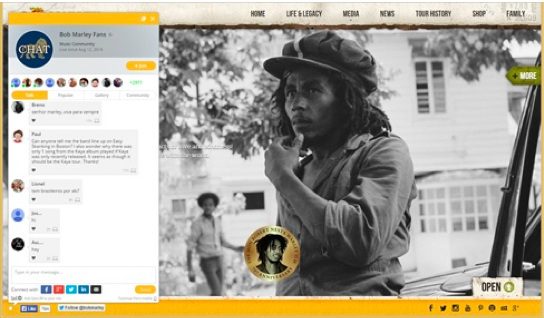“The Structure of a Proper Client Proposal That Will Land You a Blogging Gig” plus 1 more |  |
| The Structure of a Proper Client Proposal That Will Land You a Blogging Gig Posted: 09 Apr 2015 07:45 AM PDT This is a guest contribution from Karol K. Struggling to make money blogging, aren’t you? SEO doesn’t seem to work for you. Neither does social media. And don’t even get me started on commenting on other blogs and online forums … it’s just noise. Maybe you even subconsciously hate people like Darren, Jon Morrow, or Brian Clark, purely because they’ve succeeded and you haven’t (yet). First of all, it’s okay. Don’t worry, not being satisfied and trying to look for outside reasons to justify our problems is a natural human reflex. It will pass. Second of all, maybe you’ve been putting your efforts in the wrong place… I don’t want to sound too much like a preacher of some kind, but there really are different ways of making money through a blog out there, and they don’t all revolve around: (1) creating content, (2) building an audience, (3) selling info products to that audience. This is just one of the possible methods. A very sound method if executed properly, but still just one among many. For instance, a counter approach I’d like to present to you today is based around freelance blogging. In other words, it’s about offering blogging services to other website owners. Or to say it even more plainly, it’s about getting paid to blog. So naturally, the most important question here is how do you convince anyone to hire you, and why would they even want to hire you to write for them if they have a pair of perfectly good writing hands themselves? This is what we’re going to answer today. Namely, we’re going to discuss how to craft a proposal that will win you freelance blogging gigs. The method I like to use is something I call the hungry carnivore tactic. Corny, I know. But it works. It’s a four-step process:
Let’s take it from the top. 1. Induce hungerIt all starts when the carnivore enters a restaurant – your restaurant. (The carnivore is just a metaphor for your client, by the way.) The first thing you need to do when you set your eyes on that prospective client is to induce hunger in them. You want them to feel exactly like a person feels when they enter a restaurant and see everybody eating. In such an environment, they will become hungry right away and inevitably order something. So how do you do this to a client? A very good starting point is identifying their problem and talking about it openly. You want to appeal to them by making things tailor-made. For example, you don’t actually want to offer a standard blog writing service. Instead, you should identify the areas where the prospective client’s blog is lacking and point those areas out. When you do so, the client will start craving a solution. As much as possible, try using research data when talking about problems. For instance, if you’re pointing out that the client posts irregularly, try looking up a study about standard blog ROI vs. posting frequency; just to name one possibility. In general, the more you can help your client to understand the issues that need to be addressed, the more they will want to hire you. 2. Serve the appetizerThis is the time to start serving up your solutions. So to grab your carnivore and make them pay attention to you, serve an appetizer that presents a good overview of what’s to come – the meat. This is about listing goals and objectives – the main vision of what you can provide as a freelance blogger. Focus on the following:
Doing all this might sound like a lot of unnecessary work. I mean, after all, why wouldn’t you just send a standard pitch and offer a simple writing service, right? Well, you can do that, but you’ll be leaving a lot of business on the table. And it’s not just me talking. Here’s what Ruben Gamez – the founder of Bidsketch (client proposal software for freelancers) – thinks about the no.1 mistake that freelance bloggers make when building a pitch or a proposal:
Ruben surely knows what he’s talking about here, considering the fact that he’s built his whole business based on his client proposal skills and years of experience in that area. Essentially, this is what appetizers are about – getting someone more excited about the main dish that’s to come. Which brings me to: 3. Serve the meatThis is “the what” of your offer. In this part, you need to take the things you’ve talked about in the appetizer and list a specific solution that you’re going to provide. There’s a handful of important elements you should focus on here:
Now the tricky part. Try offering more than one possible option. The sweet spot is three. Here’s how:
No typo there, by the way. Tiers #2 and #3 have the same price tag. This is the whole trick. The goal is to convince the client to always go for the most expensive option. If I’m not mistaken, I first learned about this in Predictably Irrational by Dan Ariely. The reasoning behind this tactic is that comparing each option is hard for the human brain, so we need to provide a common denominator. In this case, it’s the price. So when the price for both options is the same, it’s easy to tell which one is a better deal. And that is most likely what the client will end up selecting. This is the meat. 4. Serve the dessertNow the final part. At this stage, the carnivore should already be fairly satisfied with what they’re seeing, so we just need to give them this final nudge. Some possibilities:
Finally, conclude with a good call to action. Just tell them what to do next. You can even use a sub-headline like “Next Steps.” Tell them how to accept your proposal and make it easy. You don’t want the client to get stuck at this point. In short, list the bare minimum of things you need from the client in order to get started with their project. The cut-out-n’-keep templateOkay, so that’s it for the theory. But I do have one more thing for you. If you’d like a complete proposal template – built on the principles explained here – just go ahead and click this link. Finally, what’s your take on this? Is freelance blogging something you’re planning to do in 2015 to grow your blog business in a more direct way? Karol K. (@carlosinho) is a freelance writer, published author, founder of NewInternetOrder.com and a blogger at Bidsketch.com (delivering some cool freelance blogging and writing tools, advice and resources just like what you're reading now). Whenever he's not working, Karol likes to spend time training Capoeira and enjoying life. Originally at: Blog Tips at ProBlogger |
| Why Should I Make My Webpage Interactive? Posted: 09 Apr 2015 07:07 AM PDT This is a guest contribution from Ben Shwartz. They say you shouldn't judge a book by its cover… but does that extend to eBooks? How about webpages? In the current state of our globalized, media-saturated society, it's difficult—if not outright impossible—to live by this seemingly antiquated adage. Amidst the hustle and bustle of the World Wide Web, appearance often conquers content in terms of user retention, which makes your landing page the golden ticket to your website's success.
Generating a home page with interactive features (think layered multimedia and on-site social networking) allows the fireworks to come directly to the customer, instead of having the customer waste his or her precious time searching for what exactly it is that you have to offer. With that said, put your best foot forward and take advantage of all the…well, advantages, an interactive site can procure. Capture the social media-unfriendly.For better or for worse, social media often gets a bad rap. For the stubborn old-timers, social media shy, and those who are proud to have never given a virtual thumbs-up or double-tapped to "like," having an on-site source for communication can be an easy (and potentially covert) transition to get these hesitant folks more inclined to digital networking. If you've already won the first battle by getting them to your site in the first place, the immediate presence of focused content and engaging topics relevant to their interests may compel them to take part in the conversation. Easy, automatic signup options (i.e. via your email account) saves time and gets the user directly apart of the conversation. As a bonus, user profiles are limited within the site's perimeters, ensuring an extra level of privacy that will be happily received by any reluctant recluse. For the sake of organization.If you're a startup or an e-commerce retailer, chances are you have a string of social media accounts representing your business all around the web. From obvious mainstays like Facebook and Twitter to the more professional LinkedIn and less structurally restrictive Tumblr, there's a whole pond full of big name outlets for one little fish to navigate. Streamline key topics of interest to establish your site as the primary source of discussion, so as to provide a clear, exact, and timely authority on your site's content. Allow your social media links to direct traffic back to your site, whether they target new customers with catchy captions or retain existing customers with reminders regarding updates to the content with which they are already familiar. On the contrary, if you're looking to give your customers some extra context that you find may interest them (and thus further establish yourself as a thought leader), multimedia tools are available on the market to create centralized hubs of outsourced interaction. Simple, customizable icons link to related and relevant content. Should one recommendation prove beneficial to your customer, there's a good chance you've converted him or her into a repeat user on your own site. Enjoy the benefits of live personal presence in real-time.Social networking, especially within a particular niche, can quickly get to look a lot like a high school cafeteria. You have a few cheerleaders on the hunt for prom dresses, a gaggle of brainiacs preparing for the next Comic-Con, and devoted group of traveling Phish fans. While each individual adheres to a different class schedule, eating at the lunch table affords a precious punctual platform from which to vocalize their hopes, needs, and desires. While these "lunch tables," or online outlets for communication, do currently exist (and in great numbers), the current state of cyber affairs stimulates the desire for instant gratification, or feedback in real-time. While alerts and notifications on other outlets can remind you of existing conversations, having an on-site communication tool allows a more organic flow of communication. Customers can feel that they're actually a part of a dynamic conversation, rather than uttering anonymous nothings to the wind. Users can create more substantial relationships with one another and in turn, return to the site to continue these budding interest-based friendships. Topics will be more likely to stay on course given their placement in a centralized, authoritative position, and you will be more likely to sustain P2P relationships given that your site will be the common link (literally) shared between viewers. Just like in high school, everyone wants to be a part of a group and their conversation. Your on-site social network will give your viewer a voice and heighten the likelihood that he or she will be heard. Educate others while educating yourself.In terms of building a community, user retention is more likely to increase if your viewers feel at home. If they're already engaging in a conversation, they're more likely to resume input if they feel that they're in a group consisting of thoughtful peers based on mutual interests and respect. Having one (or several) of your team members as an active social presence on your site is a win-win for all parties. From a customer's perspective, they can gain insight from interaction with a thought leader, and the informal setting in which it takes provides a more humanized and less formal or mechanical component. Additionally, it goes without saying that a business needs to determine its customers' desires and interests, and having an inside source on the front lines is one of the easiest ways to do just that. By learning the popular topics in your forums, you'll have a better idea of what can be added, edited, or removed to maximize your website's potential and propel your future business goals. In essence, an interactive website prioritizes and centralizes not only the products by also the discourse associated with your brand. Your landing page is your money maker, given its status as your company's official authority. If we stay with the times and realize that consumers must be efficiently engaged to ensure conversion, then we must recognize how important it is to create a visually appealing product that provides a one-stop shop for your audience's needs. Finally, consumers strive for a human connection rather than a technical, formalized response to their social networking input. Combine winning visuals with interactive, informal discussions to ensure that your site is one worth reading from one day to the next. Ben Shwartz is the VP of Marketing for Spot.IM. He loves to buy and sell websites, and immerse himself in anything and everything in the realm of online marketing. Originally at: Blog Tips at ProBlogger |
| You are subscribed to email updates from @ProBlogger To stop receiving these emails, you may unsubscribe now. | Email delivery powered by Google |
| Google Inc., 1600 Amphitheatre Parkway, Mountain View, CA 94043, United States | |














.jpg)
0 comments:
Post a Comment